Published 12:00 am Wednesday, December 2, 2009
By Mark Wineka
Salisbury Post
Most of the initial bronze historical markers that are part of the Salisbury History and Art Trail are now in place, and a map brochure is being published for people wanting to find the markers on their own self-guided tours.
Initially, 14 markers have been produced thanks to funding from the Proctor Foundation, Woodson Foundation, Edward and Susan Norvell and the city of Salisbury. Two more are on order, for installation by this summer or fall.
Up to eight more markers are in the works for 2008. The Woodson Foundation recently donated $8,000 toward the new round of markers next year.
The markers touch on five different eras in the city’s history ó Colonial-Backcountry, Antebellum, Civil War & Reconstruction, Railroad & Industrial and Modern.
For location purposes, they also are identified on the pending map brochure in connection with four downtown squares or wards: East (E), North (N), South (S) and West (W).
When ready, the brochure will be available at the Rowan County Convention & Visitors Bureau (204 E. Innes St.) and other selected downtown locations. Meanwhile, the map on this page reproduces the locator map in the brochure to come.Here is a rundown of each location on the map, including the first 16 historical markers and eight existing locations of public art.
Colonial-Backcountry
– N-2 ó Elizabeth Maxwell Steel: During the Revolutionary War, Gen. Nathanael Greene sought shelter in her tavern located on this site. (Installed.)
– N-1 ó John Steele: Appointed by George Washington as the first comptroller of the United States, he also served multiple terms in the N.C. House of Commons. (Installed.)
Antebellum
– S-4 ó Banking on Bank Street: An imposing two-story brick structure once dominated this corner, where the Salisbury Farmers Market is now located. It housed a series of banking establishments from the early 1880s until 1889. (This marker will have a granite base when it’s installed in coming weeks.)
– E-6 ó Coming of the Railroad: A daylong barbecue stretched into the evening to celebrate the arrival of the first locomotive in Salisbury. Sweeping changes came with the railroad and boosted the town’s economy. (Installed.)
– W-6 ó Hinton Rowan Helper: Around 1850, he was a young apprentice clerk in Salisbury, but he soon captured national attention as the author of a controversial expose on slavery. (Installed.)
Civil War & Reconstruction
– S-1 ó John Willis Ellis: Elected to two terms as N.C. governor, he served at a pivotal time in the state’s history when it seceded from the Union in 1861. (To be installed this summer or fall.)
– E-1 ó William Valentine: A free man of color, he was a well-known and respected barber in the 1850s. While his whereabouts during the Civil War are unknown, he was back in business by 1869. (To be installed soon, either on the old Kluttz Drug Store site or next to it.)- E-2 ó Joseph Ballard: The image of blacksmith and politician Joe Ballard was featured on three postcards published by Theo Buerbaum ó a testament to his popularity with local townspeople. (Installed.)
– E-7 ó Salisbury Arsenal: It occupied an expansive lot adjacent to the railroad during the Civil War. Union Gen. Stoneman destroyed the arsenal near the end of the war because it was an important supply hub for the Confederate Army. (To be installed soon on a granite base.)
Railroad & Industrial
– N-6 ó Lee Slater Overman: He served nearly 28 years on Capitol Hill, was president of the N.C. Railroad and a trustee of both Duke University and the University of North Carolina. (To be installed this summer or fall.)
– S-2 ó Meroney’s Theatre: Stage productions are once again the featured attractions at what today is called Meroney Theatre. In its early heyday, the theatre brought well-known performers from New York and elsewhere to Salisbury. (Installed on the theater building.)
– W-1 ó Theo Buerbaum: He was a prominent civic leader whose most lasting contribution to the community was his many photographs, published as postcards at the turn of the 20th century. (Installed.)
– W-3 ó Salisbury Cotton Mills: One of the first and largest textile mills in Rowan County, it resulted from a revival meeting held in a warehouse that once stood here.
Modern
– S-3 ó Sister Cities: The marker commemorates an official sister-city relationship between Salisbury, N.C., and Salisbury, Wiltshire, England. (Installed.)
– S-5 ó Death of Otto Wood: The demise of the infamous outlaw after a scuffle with local law enforcement on this Salisbury city street captivated the interest of thousands who turned out to view his body at a local funeral home. (Installed.)
– W-5 ó Integration: The days of segregated movies in Salisbury came to a quiet end in 1962 after a group of Livingstone College students protested outside the Capitol Theatre, which once stood on this site. (Installed.)
Public Art
– N-3 ó Rowan Museum Garden and 1888 Iron Fence: The fence once encircled a fountain that stood in the middle of Salisbury at the intersection of Main and Innes streets. The fountain and fence were removed in 1905 to make way for a streetcar.
– N-4 ó Oak Grove-Freedman’s Cemetery: The burial site for more than 150 known and unknown enslaved and free African-Americans, it’s a public art memorial standing as a symbol to acknowledge the past, challenge visitors to think about the present and offer hope for the future.
– N-5 ó Confederate Monument: The 14-foot bronze statue was designed at a cost of $10,000 by sculptor Frederick W. Ruckstuhl. The widow of Gen. Stonewall Jackson attended its dedication in 1909.
– E-3 ó Waterworks Visual Arts Center Sculpture & Sensory Gardens: The gardens showcase nature’s forms, colors and textures, and rotating exhibits feature provocative sculpture by area and regional artists.- W-2 ó Mural, “Crossroads: Past and Present”: Commissioned by the Rowan Art Guild, the mural covers 6,000 square feet and depicts downtown Salisbury at the turn of the 20th century. More than 100 local residents in period dress populate the mural.
– E-5 ó Robertson Eastern Gateway Park Fountain: The park’s fountain is a replica of the one that stood in the center of town at the turn of the 20th century. It was cast from original molds owned by Robinson Iron Works of Alexandria City, Ala.
– E-4 ó Mosaic Mural: Salisbury artist Robert Crum designed and created the mural with more than 100,000 tiles in 2005. Commissioned by the Salisbury Community Appearance Commission.
– W-4 ó Frances Fisher Tiernan: The monument was erected in 1938 as a memorial to Tiernan, best known by her pen name, Christian Reid. She published more than 40 novels, and she wrote her play, “Under the Southern Cross,” to raise funds for the Confederate Monument.





